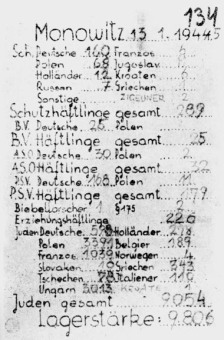Prisoner Strength and Composition of the Prisoner Groups

At the construction site of I.G. Farben in Auschwitz-Monowitz, prisoners from a considerable number of European countries were used for slave labor.
The Buna external work detachment, introduced in spring 1941, initially was made up chiefly of Polish prisoners; added to it in spring 1942 were Jewish inmates from France, who were housed in the Auschwitz main camp. In June 1942, as part of a larger transfer program, the SS began transporting non-Jewish Polish prisoners from Auschwitz to concentration camps of the so-called Altreich (“Old Empire”). This resulted in an increase in the percentage of Jewish prisoners in the Buna external work detachment, and in the course of time Jews came to constitute an overwhelming majority in the overall camp population.
In late October 1942, the SS transferred an initial group of prisoner functionaries from the Auschwitz main camp to the newly opened Buna/Monowitz concentration camp. In the following weeks, the number of the camp’s inmates grew rapidly. On October 27, 1942, a deportation train from the Westerbork concentration camp in the Netherlands arrived with 841 Jewish prisoners, of whom only 224 men were selected as “fit for work” and “transferred” to Monowitz. The remaining deportees were gassed in Birkenau. Two days later, there followed a transport with prisoners from the Dachau concentration camp, who were scheduled to work on building I.G. Farben’s Buna rubber plant. On October 30, 1942, in the main camp, the SS selected around 800 male Jewish prisoners from the German Reich as “fit for work” and moved them to Monowitz. By the end of October 1942, there were 2,100 prisoners in the Buna/Monowitz concentration camp. In September 1943, 5,400 of the 6,500 inmates were deployed as a workforce for I.G. Auschwitz. In summer 1944, the camp’s prisoner strength reached its highest point at more than 11,000 inmates, as hundreds of thousands of Jews, male and female, from Hungary were carried off to Auschwitz. Some of those selected at the ramp in Birkenau as “fit for work” were “transferred” to Buna/Monowitz and housed there in tents. On New Year’s Day 1945, there were 10,350 prisoners in the Buna/Monowitz concentration camp.
Some 90 to 95 percent of the prisoners in Buna/Monowitz were Jews, who came from Germany, Austria, Poland, France, the Netherlands, Belgium, Norway, Greece, Hungary, Romania, Serbia, Italy, Luxembourg, and Czechoslovakia. Among the non-Jewish inmates, Poles, citizens of the USSR, and so-called Reichsdeutsche predominated. In addition, there were the Sinti and Roma, who accounted for about 1 to 2 percent of Monowitz’s inmate population. After succesful escape attempts, the SS transferred a good many of the Polish and Czech prisoners to the concentration camps of Buchenwald and Sachsenhausen in the summer of 1943.
The prisoner population of the Buna/Monowitz concentration camp consisted almost exclusively of men. The exception was a small group of about 10 to 20 Polish women forced to serve as prostitutes. No later than summer 1944, perhaps even as early as the end of 1943, they were housed in a brothel block surrounded by additional fencing.
The functionary positions inside the camp—as block elders, prisoners on barracks-room cleaning duty, block and camp clerks, prisoner physicans, and medical orderlies—or outside the camp as Kapos of work detachments were held primarily by inmates from the German Reich, or from Austria and Poland. In addition to political and personal connections, the ability to understand the commands delivered in German by the SS played a major role here.
(FS; transl. KL)
















